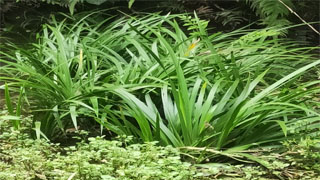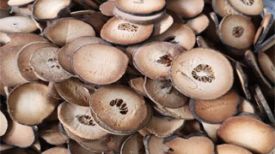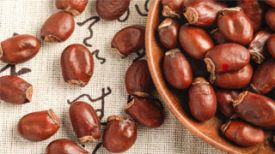
1. Alias
Water Sword Grass, Stone Centipede, Water Centipede, Ge Pu.2. Plant morphology
Perennial herb. The root and stem lie horizontally, with a yellow brown outer skin. Leaves basal, sword shaped linear, apex gradually pointed, dark green, glossy, parallel veins, no midrib. The flower stem is flattened and triangular; Buddha flame bud leaf shape; The fleshy inflorescence emerges from the side of the central part of the Buddha's flame bud, without a stem, slanting upwards or slightly upright, in a narrow cylindrical shape, weak and delicate; Flower bisexual, light yellow green, densely growing; Flower quilt 6, two columns; 6 stamens, slightly longer than the perianth, yellow anthers, flattened filaments; Ovary is oblong in shape. Berry flesh, oblong in shape. The flowering period is from June to July, and the fruiting period is in August.
3. Origin distribution
Born in valleys, mountain streams, and among the water and rocks of springs. Distributed in Henan, Shandong, Jiangsu and other places.
4. Harvesting and processing
Harvesting in autumn, removing stems, leaves, and roots, washing, or cutting into small pieces about 10 centimeters long, and drying in the sun.
5. Characteristics of medicinal herbs
Flat cylindrical, slightly curved, often branched, 3-20 cm long, 0.3-1 cm in diameter. The surface is brown, brownish red or grayish yellow, rough, with multiple segments, and internodes are 0.2-0.8 centimeters long; There are slightly flattened triangular leaf scars on the upper side, arranged horizontally, and circular root scars on the lower side. Sometimes there are fibrous leaf bases remaining at the nodes. Hard and brittle in texture, fibrous in fracture surface, almost white or slightly red in color, with obvious inner layer rings in transverse section, and visible small vascular bundle points and brown oil spots. Fragrant aroma, bitter and slightly spicy taste. It is better to have thick stripes, a white cross-section color, and a strong aroma.
6. Sexual Taste Returning to the Classics
Slightly warm in nature, with a pungent and bitter taste. Returning to the Heart Meridian and Stomach Meridian.
7. Effect and Function
Open the orifices, expel phlegm, regulate qi, promote blood circulation, dispel wind, and remove dampness. It belongs to the category of orifice opening medicine.
8. Clinical application
Use 3-6 grams. Or into pill powder. For external use, boil and wash with water or grind and apply. Used to treat epilepsy, phlegm fainting, fever induced dizziness, forgetfulness, shortness of breath and hearing loss, chest distress, stomach pain, abdominal pain, wind cold dampness, abscess, swelling and toxin, and injuries caused by falls and blows. Mash the juice of Acorus calamus and ginger together and pour it down to treat phlegm and confuse the mind.
9. Pharmacological research
It has pharmacological effects such as sedation, anticonvulsant, improvement of memory loss, cough suppression, phlegm elimination, spasmolysis, antibacterial, antiarrhythmic, lipid-lowering, orifice opening, and anti-tumor. Toxic, with certain carcinogenic and mutagenic effects.
10. Chemical composition
Mainly containing volatile oil. The main components of volatile oil are 32 trace components, including Asarone and Cinnamomum camphora oil, α - Asarone, β - Asarone, Euasarone, Acorus calaminee, Phellodendron, α - Cedriol, Cinnamaldehyde, α - Cedriol, Turquoise ketone, Acorus calamus ether, Acorus calamine A, Acorus calamine B, eugenol, etc.
11. Usage taboos
Those with yin deficiency and yang hyperactivity, excessive sweating, and slippery semen should take it with caution.
12. Related prescriptions
① To treat toothache caused by wind worms: Use Acorus tatarinowii to bite on the painful area of the tooth, or plug the gap. (Ancient and Modern Medical System)
② Treating urination dozens of times a day and a night: dividing Acorus tatarinowii and Coptis chinensis into two equal parts. Use a square sized dagger to sieve wine and drink. (Fan Wang Fang)
③ To treat sore throat: Mash the roots of Acorus tatarinowii, boil them with an iron scale hammer, and drink a glass of wine. (St. Francis of Assisi)
④ Treating phlegm and confusing the mind: Acorus tatarinowii, ginger. Pour the juice together. (New Compilation of Mei's Formula Testing)
⑤ Treating abscess and swelling on the back: Rub and paste raw Acorus calamus. If the ulcer is dry, grind it to powder and apply it with water. (Experience Formula)
⊙ The content of the article is for clinical reference only. Non TCM professionals are not allowed to test drugs.


